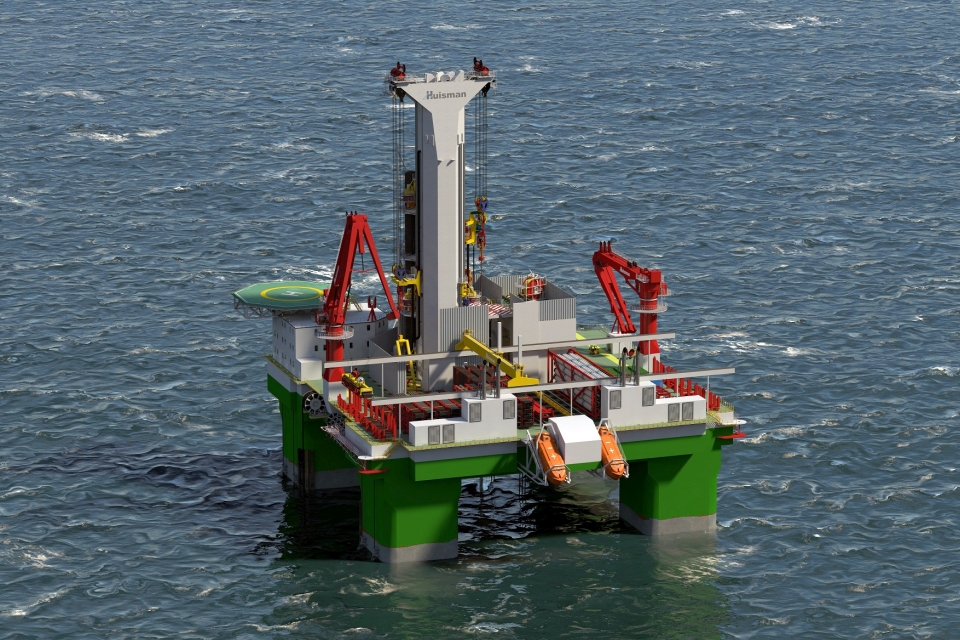Facing an energy supply gap due to rapid decline of traditional fossil fuel sources and fast, but not fast enough, growth of renewable energy sources, Huisman has arrived at a solution. The company’s Harsh Environment Semi-Submersible Drilling Rig is aimed at making the extraction of fossil fuels as sustainable as possible while we make the transition to renewable energy.
Huisman says the company is working towards the energy transition, developing numerous solutions for the harvesting of renewable energy. This includes those for offshore and onshore wind as well as geothermal energy. However, to ensure energy security during the transition, the company continues to develop increasingly sustainable solutions for conventional energy production.
This approach is being given additional stimulus by current geopolitical situations, which threaten the traditional supply lines of energy. To ensure reliable access to energy at this time, Europe is being forced to consider a range of alternative sources. This includes the potential of making wider use of North Sea gas reserves – “local” offshore production offers the lowest carbon footprint relative to other fossil fuel options such as LNG and coal, while providing energy security.
Also read: Huisman to supply Leg Encircling Crane to Cadeler’s F-class vessel
Reducing the carbon footprint of a drilling rig
Huisman believes, however, that even this carbon footprint can be reduced. It has, therefore developed a Harsh Environment Semi-Submersible Drilling Rig that will lower emissions significantly. The philosophy behind the rig is one of holistic optimal efficiency. As a result, the rig offers both significant cost and emissions reduction.
Examples of the rig’s efficiency include a low drag electrified robotic drilling system that offers consistent speed of operation, as well as a unique heave compensated drilling floor, able to operate in rough seas. This results in increased productivity and uptime of the rig. Together with the rig’s sustainability-focused hybrid power system, including energy storage systems storing regenerated energy, this ensures that emissions can be reduced by thirty to forty per cent per well.
A forty per cent reduction of onboard personnel and a large functional deck space contribute to this emission reduction.
Also read: Huisman lands Seaway 7 contract for 3000-mt monopile lifting Spreader Bar
Hydroelectricity or floating wind
Ideally, the rig is powered with onshore-produced hydroelectricity, via a power cable from a nearby platform. Alternatively, it can be powered by two floating wind turbines, moored next to the rig. Both radical, but realistic solutions offer extremely low emissions per well. With inclusion of the wind turbines, the reduction in emissions can be increased to as much as 86 per cent.
‘It’s clear that we need an intermediary solution while we make the transition to renewables,’ says Dieter Wijning, Huisman Product Manager. ‘And that, if Europe is to have a reliable source of energy for the time being, this is going to involve consumption of oil and gas. We think it’s important that this exploitation of fossil fuel reserves is done as efficiently and cleanly as possible. It is our vision to drive the growth of renewable energy while making fossil fuel extraction more sustainable.’
Also read: Huisman lands US contract for rock installation equipment
Features and benefits
Features and benefits of the Harsh Environment Semi-Submersible Drilling Rig according to Huisman are:
- High efficiency robotic drilling system
- Unique heave compensated drill floor
- Fully hands off deck handling
- Hybrid power system with external connection
- Forty per cent less people on board
- 25 per cent lower cost per well
- Up to 86 per cent fewer emissions per well
Also read: Huisman presents 700-mt Travelling Quayside Crane for wind turbine components








